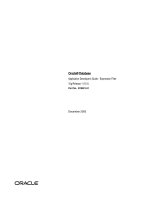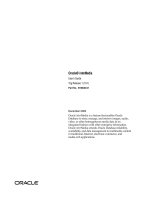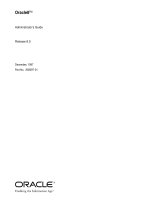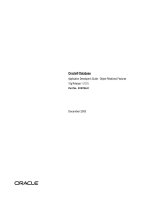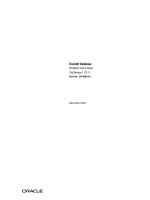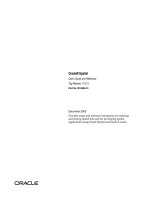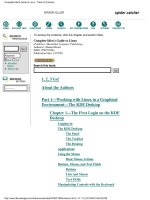Tài liệu PL-SQL User''''s Guide and Reference pdf
Bạn đang xem bản rút gọn của tài liệu. Xem và tải ngay bản đầy đủ của tài liệu tại đây (3.15 MB, 590 trang )
PL/SQL
User’s Guide and Reference
Release 8.1.5
February 1999
Part No. A67842-01
PL/SQL User’s Guide and Reference, Release 8.1.5
Part No. A67842-01
Copyright © 1999, Oracle Corporation. All rights reserved.
Author: Tom Portfolio
Graphics Artist: Valarie Moore
Contributors: Dave Alpern, Chandrasekharan Iyer, Ervan Darnell, Ken Jacobs, Sanjay
Kaluskar, Sanjay Krishnamurthy, Janaki Krishnaswamy, Neil Le, Kannan Muthukkaruppan,
Shirish Puranik, Chris Racicot, Ken Rudin, Usha Sangam, Ajay Sethi, Guhan Viswanathan
The Programs are not intended for use in any nuclear, aviation, mass transit, medical, or other
inherently dangerous applications. It shall be the licensee’s responsibility to take all appropriate
fail-safe, backup, redundancy and other measures to ensure the safe use of such applications if the
Programs are used for such purposes, and Oracle disclaims liability for any damages caused by such
use of the Programs.
The Programs (which include both the software and documentation) contain proprietary information of
Oracle Corporation; they are provided under a license agreement containing restrictions on use and
disclosure and are also protected by copyright, patent, and other intellectual and industrial property
laws. Reverse engineering, disassembly, or decompilation of the Programs is prohibited.
The information contained in this document is subject to change without notice. If you find any
problems in the documentation, please report them to us in writing. Oracle Corporation does not
warrant that this document is error free. Except as may be expressly permitted in your license agreement
for these Programs, no part of these Programs may be reproduced or transmitted in any form or by any
means, electronic or mechanical, for any purpose, without the express written permission of Oracle
Corporation.
If the Programs are delivered to the U.S. Government or anyone licensing or using the Programs on
behalf of the U.S. Government, the following notice is applicable:
Restricted Rights Notice Programs delivered subject to the DOD FAR Supplement are "commercial
computer software" and use, duplication, and disclosure of the Programs including documentation, shall
be subject to the licensing restrictions set forth in the applicable Oracle license agreement. Otherwise,
Programs delivered subject to the Federal Acquisition Regulations are "restricted computer software"
and use, duplication, and disclosure of the Programs shall be subject to the restrictions in FAR 52.227-19,
Commercial Computer Software - Restricted Rights (June, 1987). Oracle Corporation, 500 Oracle
Parkway, Redwood City, CA 94065.
Oracle, Oracle Call Interface, Oracle Developer, Oracle Forms, Oracle Reports, and SQL*Plus are
registered trademarks of Oracle Corporation. Net8, Oracle8i, PL/SQL, Pro*C, and Pro*C/C++ are
trademarks of Oracle Corporation. All other company or product names mentioned are used for
identification purposes only and may be trademarks of their respective owners.
i
Contents
Send Us Your Comments xv
Preface xvii
1 Overview
Main Features 1-2
Block Structure 1-2
Variables and Constants 1-3
Cursors 1-5
Cursor FOR Loops 1-6
Cursor Variables 1-6
Attributes 1-7
Control Structures 1-8
Modularity 1-11
Data Abstraction 1-13
Information Hiding 1-15
Error Handling 1-16
Architecture 1-17
In the Oracle Server 1-18
In Oracle Tools 1-19
Advantages of PL/SQL 1-20
Support for SQL 1-20
Support for Object-Oriented Programming 1-21
Better Performance 1-21
Higher Productivity 1-22
ii
Full Portability 1-22
Tight Integration with SQL 1-23
Security 1-23
2 Fundamentals
Character Set 2-2
Lexical Units 2-2
Delimiters 2-3
Identifiers 2-4
Literals 2-7
Comments 2-9
Datatypes 2-10
Number Types 2-11
Character Types 2-14
NLS Character Types 2-19
LOB Types 2-21
Other Types 2-22
User-Defined Subtypes 2-24
Defining Subtypes 2-24
Using Subtypes 2-25
Datatype Conversion 2-27
Explicit Conversion 2-27
Implicit Conversion 2-27
Implicit versus Explicit Conversion 2-28
DATE Values 2-28
RAW and LONG RAW Values 2-29
NLS Values 2-29
Declarations 2-29
Using DEFAULT 2-30
Using NOT NULL 2-31
Using %TYPE 2-31
Using %ROWTYPE 2-32
Restrictions 2-35
iii
Naming Conventions 2-35
Synonyms 2-36
Scoping 2-36
Case Sensitivity 2-36
Name Resolution 2-36
Scope and Visibility 2-37
Assignments 2-40
Boolean Values 2-40
Database Values 2-41
Expressions and Comparisons 2-41
Operator Precedence 2-42
Logical Operators 2-43
Comparison Operators 2-44
Concatenation Operator 2-46
Boolean Expressions 2-46
Handling Nulls 2-48
Built-In Functions 2-51
3 Control Structures
Overview 3-2
Conditional Control: IF Statements 3-2
IF-THEN 3-3
IF-THEN-ELSE 3-3
IF-THEN-ELSIF 3-4
Guidelines 3-5
Iterative Control: LOOP and EXIT Statements 3-6
LOOP 3-6
WHILE-LOOP 3-9
FOR-LOOP 3-10
Sequential Control: GOTO and NULL Statements 3-15
GOTO Statement 3-15
NULL Statement 3-19
iv
4 Collections and Records
What Is a Collection? 4-2
Understanding Nested Tables 4-2
Nested Tables versus Index-by Tables 4-3
Understanding Varrays 4-4
Varrays versus Nested Tables 4-4
Defining and Declaring Collections 4-5
Declaring Collections 4-7
Initializing and Referencing Collections 4-8
Referencing Collection Elements 4-10
Assigning and Comparing Collections 4-11
Comparing Whole Collections 4-13
Manipulating Collections 4-13
Some Nested Table Examples 4-13
Some Varray Examples 4-16
Manipulating Individual Elements 4-18
Manipulating Local Collections 4-20
Using Collection Methods 4-21
Using EXISTS 4-22
Using COUNT 4-22
Using LIMIT 4-22
Using FIRST and LAST 4-23
Using PRIOR and NEXT 4-23
Using EXTEND 4-24
Using TRIM 4-25
Using DELETE 4-26
Applying Methods to Collection Parameters 4-27
Avoiding Collection Exceptions 4-27
Taking Advantage of Bulk Binds 4-29
How Do Bulk Binds Improve Performance? 4-30
Using the FORALL Statement 4-32
Using the BULK COLLECT Clause 4-34
Using FORALL and BULK COLLECT Together 4-35
Using Host Arrays 4-36
Using Cursor Attributes 4-36
v
What Is a Record? 4-37
Defining and Declaring Records 4-38
Declaring Records 4-39
Initializing and Referencing Records 4-40
Referencing Records 4-40
Assigning and Comparing Records 4-42
Comparing Records 4-44
Manipulating Records 4-44
5 Interaction with Oracle
SQL Support 5-2
Data Manipulation 5-2
Transaction Control 5-2
SQL Functions 5-3
SQL Pseudocolumns 5-3
SQL Operators 5-5
Managing Cursors 5-6
Explicit Cursors 5-6
Implicit Cursors 5-11
Packaging Cursors 5-12
Using Cursor FOR Loops 5-13
Using Subqueries 5-14
Using Aliases 5-14
Passing Parameters 5-15
Using Cursor Variables 5-15
What Are Cursor Variables? 5-16
Why Use Cursor Variables? 5-16
Defining REF CURSOR Types 5-17
Declaring Cursor Variables 5-17
Controlling Cursor Variables 5-19
Example 1 5-24
Example 2 5-25
Example 3 5-26
Example 4 5-28
Reducing Network Traffic 5-30
vi
Avoiding Errors 5-31
Restrictions on Cursor Variables 5-33
Using Cursor Attributes 5-34
Explicit Cursor Attributes 5-34
Implicit Cursor Attributes 5-38
Processing Transactions 5-40
How Transactions Guard Your Database 5-41
Using COMMIT 5-42
Using ROLLBACK 5-43
Using SAVEPOINT 5-44
Implicit Rollbacks 5-45
Ending Transactions 5-45
Using SET TRANSACTION 5-46
Overriding Default Locking 5-47
Dealing with Size Limitations 5-50
Using Autonomous Transactions 5-52
Advantages of Autonomous Transactions 5-52
Defining Autonomous Transactions 5-53
Controlling Autonomous Transactions 5-56
Example 1: Using an Autonomous Trigger 5-58
Example 2: Calling an Autonomous Function from SQL 5-59
Improving Performance 5-60
Use Object Types and Collections 5-60
Use Bulk Binds 5-61
Use Native Dynamic SQL 5-62
Use External Routines 5-62
Use the NOCOPY Compiler Hint 5-63
Use the RETURNING Clause 5-63
Use Serially Reusable Packages 5-64
Use the PLS_INTEGER Datatype 5-65
Avoid the NOT NULL Constraint 5-66
Rephrase Conditional Control Statements 5-66
Avoid Implicit Datatype Conversions 5-67
Ensuring Backward Compatibility 5-68
vii
6 Error Handling
Overview 6-2
Advantages of Exceptions 6-3
Predefined Exceptions 6-4
User-Defined Exceptions 6-7
Declaring Exceptions 6-7
Scope Rules 6-7
Using EXCEPTION_INIT 6-8
Using raise_application_error 6-9
Redeclaring Predefined Exceptions 6-10
How Exceptions Are Raised 6-11
Using the RAISE Statement 6-11
How Exceptions Propagate 6-12
Reraising an Exception 6-14
Handling Raised Exceptions 6-15
Exceptions Raised in Declarations 6-16
Exceptions Raised in Handlers 6-17
Branching to or from an Exception Handler 6-17
Using SQLCODE and SQLERRM 6-18
Unhandled Exceptions 6-19
Useful Techniques 6-20
Continuing after an Exception Is Raised 6-20
Retrying a Transaction 6-21
Using Locator Variables 6-22
7 Subprograms
What Are Subprograms? 7-2
Advantages of Subprograms 7-3
Procedures 7-3
Functions 7-5
Controlling Sides Effects 7-7
RETURN Statement 7-8
Declaring Subprograms 7-9
Forward Declarations 7-9
Stored Subprograms 7-11
viii
Actual versus Formal Parameters 7-12
Positional and Named Notation 7-13
Positional Notation 7-13
Named Notation 7-13
Mixed Notation 7-13
Parameter Modes 7-14
IN Mode 7-14
OUT Mode 7-14
IN OUT Mode 7-16
Summary 7-16
NOCOPY Compiler Hint 7-17
The Trade-Off for Better Performance 7-18
Restrictions on NOCOPY 7-19
Parameter Default Values 7-19
Parameter Aliasing 7-21
Overloading 7-23
Restrictions 7-24
How Calls Are Resolved 7-25
Avoiding Call Resolution Errors 7-27
Calling External Routines 7-27
Invoker Rights versus Definer Rights 7-29
Advantages of Invoker Rights 7-30
Using the AUTHID Clause 7-32
How External References Are Resolved 7-32
Granting the EXECUTE Privilege 7-35
Using Views and Database Triggers 7-36
Using Database Links 7-36
Invoking Instance Methods 7-37
Recursion 7-37
Recursive Subprograms 7-38
Mutual Recursion 7-40
Recursion versus Iteration 7-41
ix
8 Packages
What Is a Package? 8-2
Advantages of Packages 8-4
The Package Spec 8-5
Referencing Package Contents 8-6
The Package Body 8-7
Some Examples 8-8
Private versus Public Items 8-14
Overloading 8-14
Package STANDARD 8-15
Product-specific Packages 8-16
DBMS_STANDARD 8-16
DBMS_ALERT 8-16
DBMS_OUTPUT 8-16
DBMS_PIPE 8-17
UTL_FILE 8-17
UTL_HTTP 8-17
Guidelines 8-18
9 Object Types
The Role of Abstraction 9-2
What Is an Object Type? 9-3
Why Use Object Types? 9-5
Structure of an Object Type 9-5
Components of an Object Type 9-7
Attributes 9-7
Methods 9-8
Defining Object Types 9-12
Object Type Stack 9-13
Object Type Ticket_Booth 9-16
Object Type Bank_Account 9-18
Object Type Rational 9-20
Declaring and Initializing Objects 9-22
Declaring Objects 9-22
x
Initializing Objects 9-23
How PL/SQL Treats Uninitialized Objects 9-24
Accessing Attributes 9-24
Calling Constructors 9-25
Calling Methods 9-26
Sharing Objects 9-27
Using Refs 9-28
Forward Type Definitions 9-29
Manipulating Objects 9-30
Selecting Objects 9-31
Inserting Objects 9-35
Updating Objects 9-37
Deleting Objects 9-37
10 Native Dynamic SQL
What Is Dynamic SQL? 10-2
The Need for Dynamic SQL 10-2
Using the EXECUTE IMMEDIATE Statement 10-3
Some Examples 10-4
Using the OPEN-FOR, FETCH, and CLOSE Statements 10-5
Opening the Cursor Variable 10-5
Fetching from the Cursor Variable 10-6
Closing the Cursor Variable 10-6
Some Examples 10-7
Specifying Parameter Modes 10-9
Tips and Traps 10-10
Passing the Names of Schema Objects 10-10
Using Duplicate Placeholders 10-10
Using Cursor Attributes 10-11
Passing Nulls 10-12
Doing Remote Operations 10-12
Using Invoker Rights 10-13
Using Pragma RESTRICT_REFERENCES 10-13
Avoiding Deadlocks 10-14
xi
11 Language Elements
Assignment Statement 11-3
Blocks 11-7
CLOSE Statement 11-14
Collection Methods 11-16
Collections 11-21
Comments 11-27
COMMIT Statement 11-28
Constants and Variables 11-30
Cursor Attributes 11-34
Cursor Variables 11-39
Cursors 11-45
DELETE Statement 11-49
EXCEPTION_INIT Pragma 11-53
Exceptions 11-55
EXECUTE IMMEDIATE Statement 11-58
EXIT Statement 11-61
Expressions 11-63
FETCH Statement 11-73
FORALL Statement 11-77
Functions 11-79
GOTO Statement 11-84
IF Statement 11-86
INSERT Statement 11-89
Literals 11-93
LOCK TABLE Statement 11-96
LOOP Statements 11-98
NULL Statement 11-104
Object Types 11-105
OPEN Statement 11-113
OPEN-FOR Statement 11-115
OPEN-FOR-USING Statement 11-119
Packages 11-122
Procedures 11-127
RAISE Statement 11-132
xii
Records 11-134
RETURN Statement 11-138
ROLLBACK Statement 11-140
%ROWTYPE Attribute 11-142
SAVEPOINT Statement 11-144
SELECT INTO Statement 11-145
SET TRANSACTION Statement 11-149
SQL Cursor 11-151
SQLCODE Function 11-153
SQLERRM Function 11-155
%TYPE Attribute 11-157
UPDATE Statement 11-159
A Sample Programs
Running the Programs A-2
Sample 1. FOR Loop A-3
Sample 2. Cursors A-4
Sample 3. Scoping A-6
Sample 4. Batch Transaction Processing A-7
Sample 5. Embedded PL/SQL A-11
Sample 6. Calling a Stored Procedure A-15
B CHAR versus VARCHAR2 Semantics
Assigning Character Values B-2
Comparing Character Values B-2
Inserting Character Values B-4
Selecting Character Values B-4
C PL/SQL Wrapper
Advantages of Wrapping C-2
Running the PL/SQL Wrapper C-2
xiii
D Name Resolution
Name-Resolution Algorithm D-5
Understanding Capture D-8
Avoiding Capture D-10
Accessing Attributes and Methods D-10
Calling Subprograms and Methods D-11
SQL versus PL/SQL D-13
E Reserved Words
Index
xiv
xv
Send Us Your Comments
PL/SQL User’s Guide and Reference, Release 8.1.5
Part No. A67842-01
Oracle Corporation welcomes your comments and suggestions on the quality and usefulness of this
publication. Your input is an important part of the information used for revision.
■ Did you find any errors?
■ Is the information clearly presented?
■ Do you need more information? If so, where?
■ Are the examples correct? Do you need more examples?
■ What features did you like most about this manual?
If you find any errors or have any other suggestions for improvement, please indicate the chapter,
section, and page number (if available). You can send comments to the Information Development
department in the following ways:
■ Email:
■ Fax: (650) 506-7228 Attn: Oracle Server Documentation
■ Letter:
Oracle Corporation
Server Documentation Manager
500 Oracle Parkway
Redwood Shores, CA 94065 USA
If you would like a reply, please give your name, address, and telephone number below.
If you have problems with the software, please contact your local Oracle World Wide Support Center.
xvi
xvii
Preface
PL/SQL, Oracle’s procedural extension to SQL, is an advanced fourth-generation
programming language (4GL). It offers modern features such as data encapsulation,
overloading, collection types, exception handling, and information hiding. PL/SQL
also offers seamless SQL access, tight integration with the Oracle server and tools,
portability, and security.
This guide explains all the concepts behind PL/SQL and illustrates every facet of
the language. Good programming style is stressed throughout and supported by
numerous examples. Using this guide, you learn PL/SQL quickly and effectively.
Major Topics
Audience
How This Guide Is Organized
Notational Conventions
Sample Database Tables
xviii
Audience
Anyone developing PL/SQL-based applications for Oracle8i will benefit from
reading this guide. Written especially for programmers, this comprehensive
treatment of PL/SQL will also be of value to systems analysts, project managers,
and others interested in database applications. To use this guide effectively, you
need a working knowledge of Oracle8i, SQL, and a 3GL such as Ada, C, or COBOL.
You will not find installation instructions or system-specific information in this
guide. For that kind of information, see the Oracle installation or user’s guide for
your system.
How This Guide Is Organized
The PL/SQL User’s Guide and Reference has 11 chapters and 5 appendices. Chapters 1
through 10 introduce you to PL/SQL and show you how to use its many features.
Chapter 11 serves as a reference to PL/SQL commands, syntax, and semantics.
Appendices A through E provide sample programs, supplementary technical
information, and a list of reserved words.
Chapter 1, "Overview" This chapter surveys the main features of PL/SQL and
points out the advantages they offer. It also acquaints you with the basic concepts
behind PL/SQL and the general appearance of PL/SQL programs.
Chapter 2, "Fundamentals" This chapter focuses on the small-scale aspects of
PL/SQL. It discusses lexical units, scalar datatypes, user-defined subtypes, data
conversion, expressions, assignments, block structure, declarations, and scope.
Chapter 3, "Control Structures" This chapter shows you how to structure the flow
of control through a PL/SQL program. It describes conditional, iterative, and
sequential control. You learn how to apply simple but powerful control structures
such as IF-THEN-ELSE and WHILE-LOOP.
Chapter 4, "Collections and Records" This chapter focuses on the composite
datatypes TABLE, VARRAY, and RECORD. You learn how to reference and manipulate
whole collections of data, and how to treat related but dissimilar data as a logical
unit. You also learn how to improve performance by bulk-binding collections.
Chapter 5, "Interaction with Oracle" This chapter shows you how PL/SQL
supports the SQL commands, functions, and operators that let you manipulate
Oracle data. You also learn how to manage cursors, process transactions, and
safeguard your database.
xix
Chapter 6, "Error Handling" This chapter provides an in-depth discussion of error
reporting and recovery. You learn how to detect and handle errors using PL/SQL
exceptions.
Chapter 7, "Subprograms" This chapter shows you how to write and use
subprograms. It discusses procedures, functions, forward declarations, actual and
formal parameters, positional and named notation, parameter modes, the NOCOPY
compiler hint, parameter default values, aliasing, overloading, invoker rights, and
recursion.
Chapter 8, "Packages" This chapter shows you how to bundle related PL/SQL
types, items, and subprograms into a package. Once written, your general-purpose
package is compiled, then stored in an Oracle database, where its contents can be
shared by many applications.
Chapter 9, "Object Types" This chapter introduces you to object-oriented
programming based on object types, which provide abstract templates for
real-world objects. You learn how to define object types and manipulate objects.
Chapter 10, "Native Dynamic SQL" This chapter shows you how to use dynamic
SQL, an advanced programming technique that makes your applications more
flexible and versatile. You learn two simple ways to write programs that can build
and process SQL statements "on the fly" at run time.
Chapter 11, "Language Elements" This chapter uses syntax diagrams to show
how commands, parameters, and other language elements are sequenced to form
PL/SQL statements. Also, it provides usage notes and short examples to help you
become fluent in PL/SQL quickly.
Appendix A, "Sample Programs" This appendix provides several PL/SQL
programs to guide you in writing your own. The sample programs illustrate
important concepts and features.
Appendix B, "CHAR versus VARCHAR2 Semantics" This appendix explains the
subtle but important semantic differences between the CHAR and VARCHAR2 base
types.
Appendix C, "PL/SQL Wrapper" This appendix shows you how to run the
PL/SQL Wrapper, a stand-alone utility that enables you to deliver PL/SQL
applications without exposing your source code.
xx
Appendix D, "Name Resolution" Thus appendix explains how PL/SQL resolves
references to names in potentially ambiguous SQL and procedural statements.
Appendix E, "Reserved Words" This appendix lists those words reserved for use
by PL/SQL.
Notational Conventions
This guide follows these conventions:
PL/SQL code examples follow these conventions:
Convention Meaning
Italic Italic font denotes terms being defined for the first time, words
being emphasized, error messages, and book titles.
Courier Courier font denotes PL/SQL code, keywords, program
names, file names, and path names.
Convention Meaning
A double hyphen begins a single-line comment, which extends
to the end of a line.
/* */ A slash-asterisk and an asterisk-slash delimit a multi-line
comment, which can span multiple lines.
An ellipsis shows that statements or clauses irrelevant to the
discussion were left out.
lower case Lower case is used for names of constants, variables, cursors,
exceptions, subprograms, and packages.
UPPER CASE Upper case is used for keywords, names of predefined
exceptions, and names of supplied PL/SQL packages.
Mixed Case Mixed case is used for names of user-defined datatypes and
subtypes. The names of user-defined types begin with an
upper-case letter.
xxi
Syntax definitions use a simple variant of Backus-Naur Form (BNF) that includes
the following symbols:
Sample Database Tables
Most programming examples in this guide use two sample database tables named
dept and emp. Their definitions follow:
CREATE TABLE dept (
deptno NUMBER(2) NOT NULL,
dname VARCHAR2(14),
loc VARCHAR2(13));
CREATE TABLE emp (
empno NUMBER(4) NOT NULL,
ename VARCHAR2(10),
job VARCHAR2(9),
mgr NUMBER(4),
hiredate DATE,
sal NUMBER(7,2),
comm NUMBER(7,2),
deptno NUMBER(2));
Sample Data
Respectively, the dept and emp tables contain the following rows of data:
DEPTNO DNAME LOC
10 ACCOUNTING NEW YORK
20 RESEARCH DALLAS
30 SALES CHICAGO
40 OPERATIONS BOSTON
Symbol Meaning
[ ] Brackets enclose optional items.
{ } Braces enclose items only one of which is required.
| A vertical bar separates alternatives within brackets or braces.
An ellipsis shows that the preceding syntactic element can be
repeated.
delimiters Delimiters other than brackets, braces, vertical bars, and
ellipses must be entered as shown.
xxii
EMPNO ENAME JOB MGR HIREDATE SAL COMM DEPTNO
7369 SMITH CLERK 7902 17-DEC-80 800 20
7499 ALLEN SALESMAN 7698 20-FEB-81 1600 300 30
7521 WARD SALESMAN 7698 22-FEB-81 1250 500 30
7566 JONES MANAGER 7839 02-APR-81 2975 20
7654 MARTIN SALESMAN 7698 28-SEP-81 1250 1400 30
7698 BLAKE MANAGER 7839 01-MAY-81 2850 30
7782 CLARK MANAGER 7839 09-JUN-81 2450 10
7788 SCOTT ANALYST 7566 19-APR-87 3000 20
7839 KING PRESIDENT 17-NOV-81 5000 10
7844 TURNER SALESMAN 7698 08-SEP-81 1500 30
7876 ADAMS CLERK 7788 23-MAY-87 1100 20
7900 JAMES CLERK 7698 03-DEC-81 950 30
7902 FORD ANALYST 7566 03-DEC-81 3000 20
7934 MILLER CLERK 7782 23-JAN-82 1300 10
Your Comments Are Welcome
We in Information Development appreciate your comments and suggestions. In
fact, your opinions are the most important feedback we receive. We encourage you
to use the Reader’s Comment Form at the front of this guide. You can also send
comments to us by
■ Email:
■ Fax: (650) 506-7228 Attn: Oracle Server Documentation
■ Letter:
Oracle Corporation
Server Documentation Manager
500 Oracle Parkway
Redwood Shores, CA 94065 USA
Overview 1-1
1
Overview
The limits of my language mean the limits of my world. —Ludwig Wittgenstein
This chapter surveys the main features of PL/SQL and points out the advantages
they offer. It also acquaints you with the basic concepts behind PL/SQL and the
general appearance of PL/SQL programs. You see how PL/SQL bridges the gap
between database technology and procedural programming languages.
Major Topics
Main Features
Architecture
Advantages of PL/SQL
